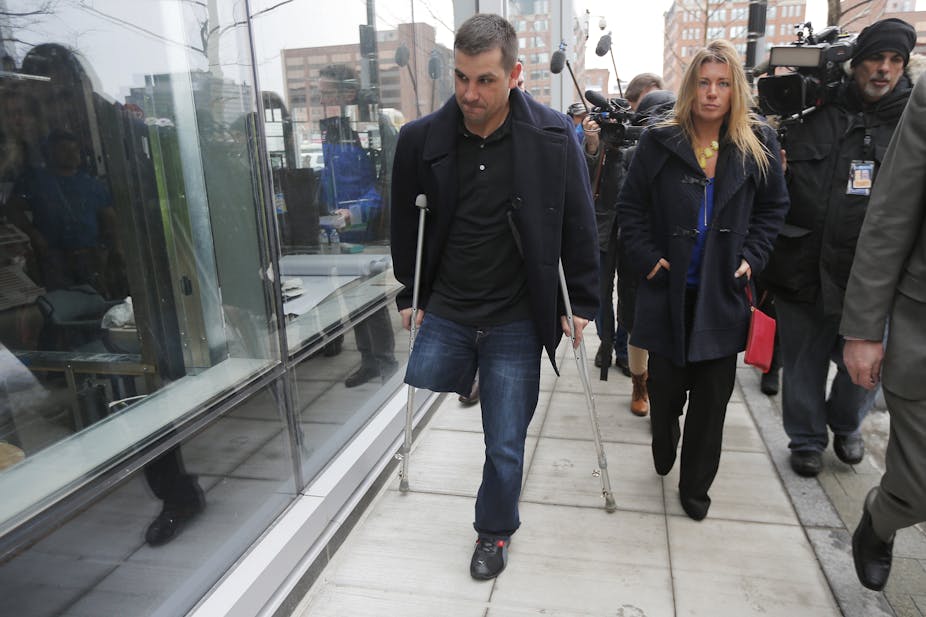The trial of the Boston Marathon bomber started with an eye-opening twist on March 4, 2015. Dzhokhar Tsarnaev’s lawyer melodramatically announced in open court that “it WAS him” who planted one of the bombs that killed three, maimed dozens and terrified an entire city.
This admission of guilt is, however, not the equivalent of the entry of a plea of guilty, as might come about through a plea bargain with the government. (In which case the defendant pleads guilty in exchange for a sentence of life).
The case is thus no longer directly about guilt or innocence, although the jury will still have to find beyond a reasonable doubt that each count has been proven.
Now, it’s all about the sentence.
Does the Boston Marathon bomber Dzhokhar Tsarnaev deserve to die for his crimes? Or should he serve life in prison without possibility of parole? This is what the federal jury will decide.
The facts
The basic facts of this case are not in doubt. Dzhokhar and his older brother Tamerlan planted two pressure cooker bombs near the finish line of the 2013 Boston Marathon.
In the resulting explosions, three people were killed, including a young boy, and hundreds were seriously injured. This crime was committed to avenge alleged offenses by the United States against Muslims and “innocent civilians.” In June 2013, the United States obtained a 30-count indictment against Dzhokhar; 17 counts carried the death penalty.
As I pointed out in my book on the historic 2004-2005 Hearings into whether or not the death penalty should be re-instated in New York state, the United States Supreme Court has said that the death penalty primarily serves three purposes: retribution, deterrence, and incapacitation.
The criteria for the death penalty
Retribution concerns moral equivalency and society’s right to inflict the harshest punishment available in our criminal justice system - death - on behalf of victims and their families. In fact, the Supreme Court has refused to authorize capital punishment for crimes short of murder.
Under the Eighth Amendment “cruel and unusual punishments” clause, only the “worst of the worst” killers may be executed. The manner of the killing and the characteristics and culpability of the defendant must be carefully assessed. In 2005, for example, the Supreme Court abolished the death penalty for juvenile offenders.
With deterrence, we ask: would execution of this 21 year old deter other terrorists from committing similar crimes? Whether the death penalty actually deters continues to be hotly debated, but it will surely be argued in Tsarnaev’s case that dedicated jihadists will not only not be deterred but are prepared for death as a path to matyrdom.
The final question regarding incapacitation is a straightforward one to answer: an executed murderer can never kill again.
The judge and jury in Tsarnaev’s trial must agree that one or more of these justifications for the death penalty is present in the case.
The importance of federal involvement
It is critically important that the Tsarnaev prosecution is being brought by the United States and not the state of Massachusetts.
Massachusetts excludes the death penalty as a sentence in a murder case. Indeed, polls showed that Massachusetts citizens generally opposed charging Dzhokhar with capital murder (a crime eligible for the death penalty.)

But, none of that matters in a federal prosecution. Federal law – the anti-terrorism laws of the United States – provides multiple categories of death penality-eligible crimes. These include such acts as using a weapon of mass destruction resulting in death and conspiracy to bomb a place of public use. These categories have been aggressively invoked by federal prosecutors in the indictments in this case.
Defense counsel strategy for the remainder of this trial is to make out Dzhokhar as a pawn of his older brother. Because of that, the argument will go, his culpability is insufficient to support a capital sentence.
Will the facts show that he was substantially under Tamerlan’s influence or was he independently motivated to kill Americans?
Did his youth, apparent timidity, or simplistic views on American military actions remove him from the “worst of the worst” category of killers? Or, is he in the same category as terrorists like the assassin “Jihadi John,” or the leader of Al-Shabaab?
By starting off its case with victim testimony, the prosecution is painting the picture of a cruel, heartless and unremorseful killer, the “worst of the worst,” who caused the death of three innocent people, including a young boy.
The government is saying, in other words, that this is a case of simple justice in which the death penalty is the only fair sentence for one whose crimes have caused so much suffering.

